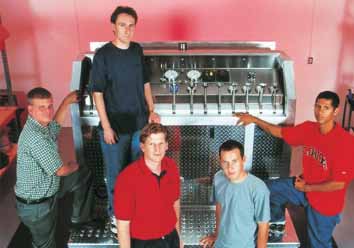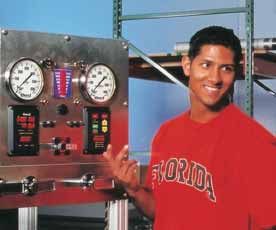|
When firefighters battling a blaze check the water pressure on their pumper truck, chances are they rely on a gauge manufactured by Class 1. This Ocala-based company controls 80 percent of the market for the roughly one dozen gauges installed on fire truck control panels.
Because competition is increasing, Class 1 engineers are always seeking to improve their designs. When one such effort ran into delays, plant manager Randy Ewers wanted solutions quickly, but he didn't want to pull any company experts off other tasks. So, the 1990 graduate of the University of Florida's industrial and systems engineering program turned to the Integrated Product and Process Design (IPPD) program at his alma mater. IPPD matches teams of advanced engineering students with companies and public agencies seeking solutions. Although the students had little professional experience, Ewers was optimistic enough to pony up the $15,000 required to participate. Based on his experience with the program — Class 1 had participated in IPPD every year since the program was founded in 1995 — Ewers was confident the students would find a solution to his problem. "The students have to bring us a deliverable — that's why we use the university," Ewers says. "That's part of their grade and it's part of their project." The IPPD program pairs "liaison engineers" from participating companies with faculty-coached undergraduate student teams in the design, construction and testing of an industrial product or process. Most students are engineering majors, although the program also includes students in the Warrington College of Business. The goal is to give future engineers and business professionals real-world experience while also assisting companies seeking engineering solutions. Students from nearly every engineering discipline participate, as do a variety of companies and public agencies. Last year, sponsors of the program's 26 projects ranged from Boeing to Dell Computer to Class 1 and Gainesville Regional Utilities. In late summer of 2001, Ewers signed Class 1 up for the program and was soon matched with a team of four students guided by Suleyman Tufekci, a UF associate professor of industrial and systems engineering. The six-credit program spans two semesters, so the students had about eight months to solve the gauge's problems — while also taking upper-level classes and working. All Details, All The TimeWe live in a world where automobiles routinely clock 100,000 miles before they need minor repairs, where hand-held computers store more data than we could remember in many lifetimes and where food is fresh, diverse and abundant year-round. The technology behind what people of a past era would have considered miraculous works so well that we often take it for granted, except on the rare occasions when it fails. More than any other group, engineers are responsible for our high standard of living, primarily because, unlike the rest of us, they sweat the details. Behind every unfailingly reliable fuel injector, every video game alien, every fresh apple in the produce section, there are complex products and processes conceived and designed by engineers. While a handful are glamorous, most are as unromantic as they are essential. As much as anything, the IPPD program introduces students to this all-important world of engineering detail. To be sure, the program has a few flashy projects, such as a Boeing assignment last year to design a part for the docking system for a proposed next-generation space vehicle. But most efforts are less sexy. Last school year, one sought to improve a latch mechanism on digital mammography imagers. The goal of another was to improve the process by which absorbents are applied to diaper factors, while a third sought new techniques to test voltage regulators used in cell phones. The Class 1 project was similarly engineering-focused. Founded in 1991, Class 1 specializes in equipment for electrical, pumping and aerial control systems on fire trucks. With 65,000 units shipped annually at a minimum cost of $30 each, its pressure gauges are steady contributors to the company's bottom line. For years, the gauges were filled with glycerin, used to dampen vibration of the needle and prevent the lens from clouding up. That design had two flaws, however. One, because it was liquid-filled, it required special machining and O-rings to prevent leaks, boosting its manufacturing cost. Two, despite these measures, after several years of use the gauges had a bad habit of leaking anyway.
Seeking a hardier and more cost-effective device, Class 1 engineers developed and patented a new mechanical technique to prevent the needle from vibrating. This eliminated one need for glycerin, but the engineers soon found that the dry gauge tended to fog up, making it hard to see the needle. Given the wet, messy conditions of firefighting, this was both predictable and unacceptable. So, the UF engineering team — composed of four seniors, each with a different major — was given two charges: find a way to keep the lens crystal clear under all conditions and figure out whether the special machining and O-rings could be eliminated now that the gauge was no longer filled with glycerin. That might seem like a no-brainer, but just as the O-rings sealed the glycerin in, they also sealed out dirt that might otherwise gum up the gauge's works. Late Deliveries And Other ProblemsIt sounds straightforward. But as students James Patchin, Phillip Thompson, Amod Saxena and Caton Cook were soon to learn, engineering is anything but routine. The students spent their first semester putting together a design outlining in detail their plans for the project. The team's approach was to try an anti-fog coating for the gauge lens — an idea suggested by Thompson, a swimmer, who noted that such a coating seemed to work well on his swimming goggles. They also came up with a battery of experiments to test the effectiveness and durability of the coating and to determine whether they could eliminate the O-rings. Along with the other teams, the students presented these plans formally at the IPPD System Level Design Review Program in the Reitz Union early last December. Dressed in business attire, the students made PowerPoint presentations to groups of industry sponsors, faculty and fellow students. The Class 1 presentation went off smoothly, reflecting the team's planning and diversity. Patchin majored in industrial and systems engineering, Thompson in materials science engineering, Saxena in chemical engineering and Caton in mechanical engineering. As the spring semester began, the students met weekly with Tufekci, the faculty adviser, to keep the project on track. But by late January, it was clear they were running into delays. The students had convinced the manufacturer of a coating used on swimming goggles to coat a handful of gauge lenses for the project for free. But the coated lenses were at least a week behind schedule, and the students didn't know when they would arrive. Tufekci was concerned. "If the company doesn't see dollar signs right in front of it, it may not act quickly enough," he told his team. "You need to stay on top of them. I don't want you to delay any of these tests." The team reported some progress on the need for the O-rings. Two members had blasted test gauges with a hose for several minutes and initial results showed the gauge's innards remained dry with or without an O-ring. The team also launched a long-term experiment to test the gauge's durability. They mounted gauges, with and without O-rings, on a metal plate under Patchin's truck, where exposure to dirt and grime would simulate years of use. They planned to re-check the gauges after several weeks. The coated lenses finally arrived in February. To test their effectiveness, the team turned to a "weather chamber" at Class 1 that exposes equipment to ideal fogging conditions of high temperature and humidity. Atop its hot, sun-drenched roof, Class 1 also hosted the durability tests. The weather chamber revealed that the coating did indeed prevent the fogging, but after a few weeks on the rooftop, the coating began flaking off the lenses, making them unusable. Rather than turn to another strategy altogether, the team decided to try polycarbonate instead of acrylic for the lens. At a late March meeting, when team members briefed Tufekci on their progress, he urged them to push forward with the polycarbonate testing. "We're finding what doesn't work, but we haven't yet found what works," he counseled them. "That's where our focus needs to be." More experiments in the ensuing weeks looked promising for the polycarbonate lenses, but the team's hopes were dashed when the students learned past experience showed the lenses turned yellow after several years. The team next turned to tempered safety glass. With graduation only weeks away, the team wasn't able to conduct a full battery of tests on the glass, but initial results were strong enough for the students to tentatively conclude the coated, tempered safety glass would work. Meanwhile, the gauges mounted on the truck and results of other experiments revealed that the O-rings were not needed to protect the gauge. The team concluded that three O-rings could be eliminated, along with the special machining. Pending a few final tests on the coated tempered safety glass, Ewers says he fully expects to integrate it into the manufacturing process while eliminating the O-rings and case machining. Overall, he said, he was pleased. "We'll be able to offer a lower-cost gauge to our customers, so that will help them reduce their costs," he said. "In our competitive market, cost is everything." Dealing With The Gray AreasIPPD programs were born in an era when American industry was losing market share to Japanese and other foreign competition with more efficient and timely manufacturing systems. One strategy industry associations pursued was to encourage universities to produce better graduates. The first IPPD-type program was created at Brigham Young University in 1991. Several others followed, including UF's in 1995. Heinz Fridrich, a 43-year career IBM employee who last served as the company's vice president for worldwide manufacturing and quality, launched the UF version of the program as a retired volunteer at the university. His combination of persistence and creativity in building the program are legendary. Win Phillips, Vice President for Research, was dean of the engineering college when Fridrich came on board. "Heinz had incredible energy, and a focused vision for the program and how it should work. He started the program quickly and it has been a great success," Phillips says. Fridrich's effort paid off. In the program's first year, 30 students and eight faculty members participated in five projects. This past school year, there were 155 students and 23 faculty members participating in the 26 projects. Fridrich remains involved, but management of the program was turned over to current director Keith Stanfill in 1999. Stanfill says that the Class 1 team's experience was in many ways typical. The program is structured carefully, with each project designed to mimic what one professional engineer could achieve in 600 hours of work. Students are supposed to spend about 15 hours per week on each project, with the industry liaison chipping in two to four hours weekly and the faculty sponsor slightly more. That said, every team encounters unexpected issues and problems.
"It is very open-ended and there are a lot of potential gray areas," Stanfill says. "Students may have to deal with a sponsor who may not be responding, or maybe hardware doesn't come in on time, or perhaps not all the students pull their weight." Some projects go better than others, and Stanfill is the first to admit there have been a few flops. The toughest challenge is to create projects of the right size: too ambitious, the students get discouraged: too easy, they lose interest. But the results of some projects can be truly impressive. For example, one team recently built a blindingly fast and inexpensive digital subscription line modem for use with existing inexpensive copper wire systems. Stanfill noted that the results of the projects are far from the only positive outcome of the program. One of its benefits is to narrow the gap between the university and the state's industry. As Ewers says, "Through the IPPD program, we've created kind of a partner relationship that has helped us out on other issues. We've connected, we know some of the faculty, and they're helpful." Befitting the original intent behind the program, there are other tangible benefits as well for students and industry. Before graduating in May, Patchin, the industrial and systems engineering student, landed a $45,000-per-year job as a management trainee at Rinker Materials in Miami. He says his experience on the IPPD team was invaluable during the interview process, and he expects it to be equally invaluable on the job. "In college, you can be as smart as you want, learn as much as you want in the book, but that's only going to get you halfway in the real world," he said. "You really have to have this experience of dealing with people, unknowns and unexpected problems, and still keep your goals in mind and come up with the solution."
Suleyman Tufekci
Related Web site:
|



